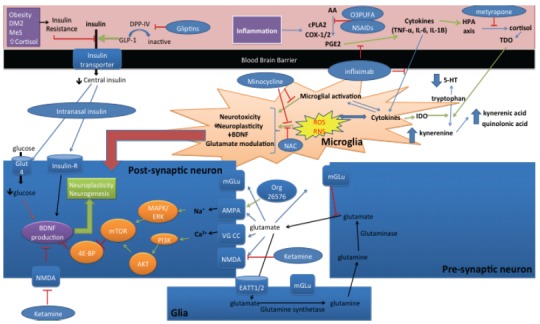Fig. (1).

Potential pathways and novel targets of TRD. (1) Inflammation increases levels of prostaglandins leading to increased cytokine levels and microglial activation leading to ROS and RNS formation which leads to neurotoxicity, decreased neuroplascticity, decreased BDNF levels and glutamate modulation. Cytokine production also leads to IDO activation, which in turn converts tryptophan to its catabolites and decreases serotonin (5-HT) levels. HPA axis activation also activates TDO, which has the same enzymatic effect of IDO. NSAIDS and O3PUFA can prevent the production of PGE2 thereby inhibiting this inflammatory-mood pathway. Similarly, infliximab can stop the pathway at the level of TNF-alpha. Minocycline can also prevent inflammation and oxidative stress. NAC can prevent oxidative stress and thus prevent the complications of ROS and RNS production. Metyrapone can prevent the production of cortisol thereby preventing TDO activation and decreasing the risk of insulin resistance. (2) Metabolic dysfunction can lead to insulin resistance and thus decreased transport of insulin across the blood brain barrier leading to decreased central levels of insulin and decreased neuronal trophic effects of insulin. GLP-1 or DPP-IV inhibitors or other insulin sensitizers such a TZDs (ex. Pioglitazone) can prevent this effect, thereby increasing the trophic effects of insulin and increasing the levels of intracellular glucose via insulin dependent uptake of glucose at Glut4 transporters. Intranasal insulin can also have this direct effect. (3) Glutamate is produced in the pre-synaptic neuron and reuptake occurs in the surrounding glia cell which converts glutamate to glutamine by glutamine synthetase and transports glutamine back to the pre-synaptic neuron where it is converted back to glutamate via the action of glutaminase. Increased synaptic glutamate levels and inhibition of NMDA by ketamine can lead to increased influx of sodium via AMPA and calcium via voltage gated calcium channels (VG CC) leading to PI3K and MAPK/ERK activation which activates mTOR, thus inhibiting 4E-BP, preventing the inhibition of BDNF production and ultimately leading to increase neuroplasticity and neurogenesis. AMPA may be directly activated by Org 26576 having a similar effect.
